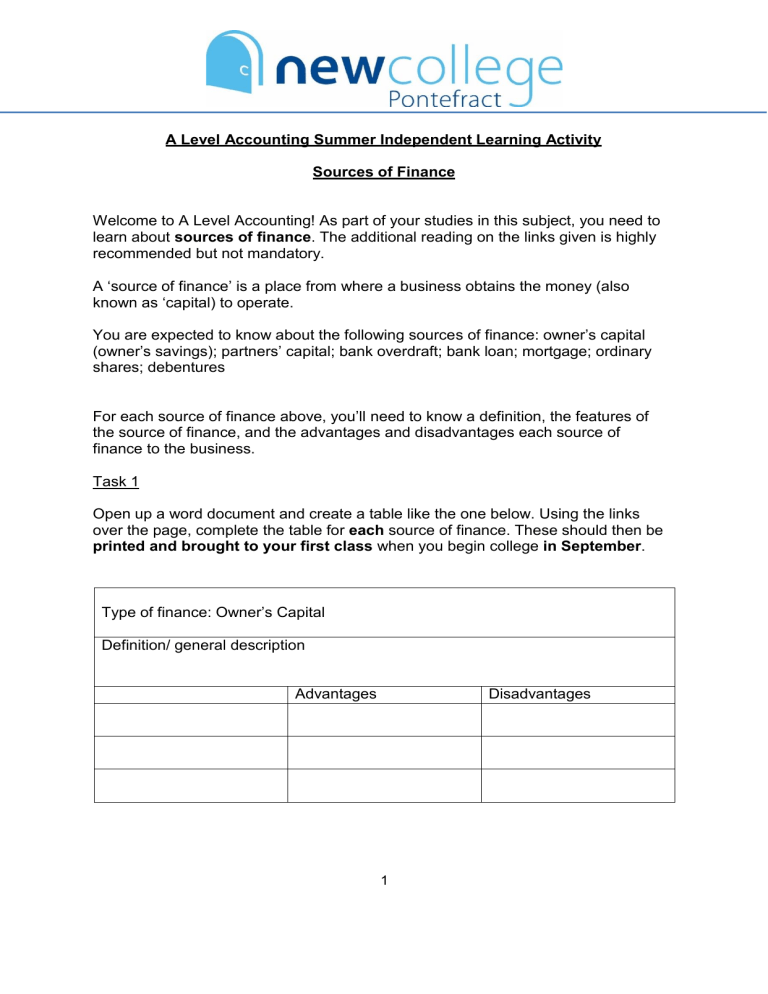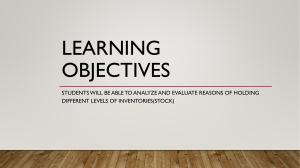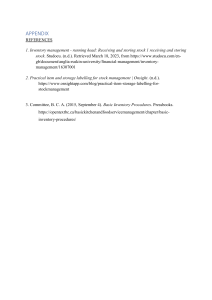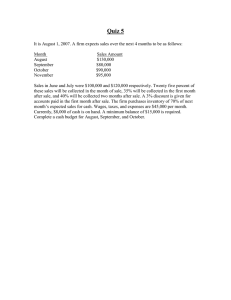A Level Accounting: Sources of Finance & Income Statements
advertisement

A Level Accounting Summer Independent Learning Activity Sources of Finance Welcome to A Level Accounting! As part of your studies in this subject, you need to learn about sources of finance. The additional reading on the links given is highly recommended but not mandatory. A ‘source of finance’ is a place from where a business obtains the money (also known as ‘capital) to operate. You are expected to know about the following sources of finance: owner’s capital (owner’s savings); partners’ capital; bank overdraft; bank loan; mortgage; ordinary shares; debentures For each source of finance above, you’ll need to know a definition, the features of the source of finance, and the advantages and disadvantages each source of finance to the business. Task 1 Open up a word document and create a table like the one below. Using the links over the page, complete the table for each source of finance. These should then be printed and brought to your first class when you begin college in September. Type of finance: Owner’s Capital Definition/ general description Advantages Disadvantages 1 A general introduction to sources of finance http://www.bbc.co.uk/education/guides/zmj7tfr/revision/1 Owner’s capital & partners’ capital https://www.tutor2u.net/business/reference/finance-personal-sources-of-finance-fora-startup https://www.tutor2u.net/business/reference/organisation-partnerships Bank Overdraft & Bank Loan https://www.tutor2u.net/business/reference/sources-of-finance-bank-overdraft https://www.tutor2u.net/business/reference/sources-of-finance-bank-loans Ordinary shares https://www.tutor2u.net/business/reference/finance-introduction-to-raising-equityfinance Debentures https://www.tutor2u.net/business/reference/debentures Task 2 Once you’ve got the required knowledge of each source of finance, the key skill you need is the ability to compare and contrast different sources of finance, in order to decide whether that particular source will benefit the business or not. A popular comparison is between money from shares (share capital) and money that comes from loans or debentures (loan capital) Using the information from task 1, analyse (explain) the differences, and similarities between loan and share capital. Make a judgement as to which you think is best for a business. Bring this to your lesson in September. 2 Income Statements Businesses have to complete an income statement. An income statement is a financial statement which must be produced every year, that shows the total sales and expenses a business has and whether it is making a profit or a loss. Please follow the link to the attached PowerPoint presentation showing the purpose and layout of an income statement. https://nclt.ac.uk/wp-content/uploads/2022/06/Summer-Independent-Learning11.pptx Task 1 a) Learn the layout of the income statement on slide 5 of the PowerPoint presentation b) Learn the key terms (see slide 6) c) Learn the formulae (slide 8) d) Work through the Matthew Lloyd worked example on the PowerPoint (slides 12, 13, 14) Once you have completed task 1, you should now be in a position to complete the following tasks, 2, 3 and 4. Task 2 You are to fill in the missing figures for the following businesses: Revenue Opening Purchases Closing Cost of Inventory Inventory Sales Gross Expenses Profit/ Profit (Loss) for the year £ £ £ £ Business A 20 000 5 000 10 000 3 000 Business B 35 000 8 000 15 000 5 000 6 500 18 750 7 250 18 500 10 500 20 750 9 100 22 750 Business C Business D 45 250 Business E 71 250 Business F 25 650 9 500 49 250 4 950 13 750 £ £ £ 4 000 10 000 11 550 3 £ 11 750 10 950 24 450 (3 450) Task 3 The following balances have been recorded by the bookkeeper of John Adams at 31st December 2017. £ £ Inventory at 1st January 2017 (opening inventory) Purchases 14 350 114 472 Revenue (Sales) 259 688 Office rent 13 718 Heating and Lighting 12 540 Wages and Salaries 42 614 Vehicle Expenses 5 817 Advertising 6 341 Inventory at 31st December 2017 is valued at £16 280 (closing inventory) You are to prepare the Income Statement of John Adams for the year ended 31st December 2017. Task 4 The following balances have been recorded by the bookkeeper of Clare Lewis as at 31st December 2018. £ Revenue (Sales) £ 144 810 Purchases 96 318 Inventory at 1st January 2018 16 010 (Opening inventory) Salaries 18 465 Heating and Lighting 1 820 4 Rent and Business rates 5 647 Sundry Expenses 845 Vehicle Expenses 1 684 Inventory at 31st December 2018 (Closing inventory) is valued at £13 735. You are to prepare the Income Statement of Clare Lewis for the year ended 31st December 2018 Profitability Ratios A business uses the income statement to analyse its progress by comparing its performance from one year to the last. It can then see whether it is improving, by making more profit, or deteriorating by making less profit. This analysis helps the business to make decisions. It does this by calculating some ratios. See slide 17 Task 5 Learn the profitability ratios Task 6 Using the income statement created for Clare Lewis, calculate the following profitability ratios: I. II. III. IV. Gross profit margin Gross profit mark up Expenses in relation to revenue Profit in relation to revenue Bring your work for tasks on sources of finance and income statements, tasks 2, 3, 4 and 6 to college on your first day Good luck and see you soon The Accounting Team at New College Learning Trust 5





